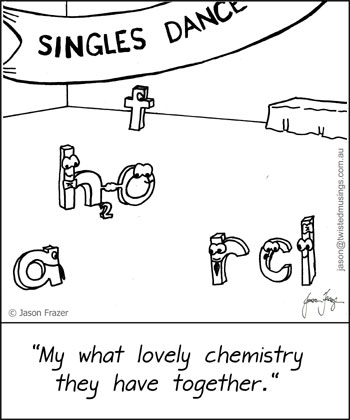-the chemicals that are reacting together
-the number of particles involved
-the type of particles involved (ie. atoms, ions, molecules)
-the number of moles per substance
-the reactants & the products
-the state of the substance (ie. solid, liquid, gas, or aqueous)
How do you write a chemical equation?
ex. solid sodium metal burns in chlorine gas to form solid sodium chloride
Sodium chloride = Na +1 + Cl -1 = NaCl
Chlorine gas = Cl2 (one of the 7 diatomics*)
Na + Cl2 --> NaCl
# of atoms on each side:
right: left:
Na - 1 Na - 1
Cl - 1 Cl - 2
To balance the right side of the equation, there needs to be 2 chloride atoms.
Na + Cl2 --> 2NaCl
Count the atoms again:
right: left:
Na - 2 Na - 1
Cl - 2 Cl - 2
Now add 2 in front of the sodium metal; therefore, the balance equation is:
2Na + 1Cl2 --> 2NaCl
And the coefficients cannot be reduced!
What are diatomics?
The diatomics are 7 special non-metals that always form a molecule of 2 when alone. They are:
Hydrogen, oxygen, fluoride, bromide, iodide, nitrogen, chloride
The diatomics are in gas form & are expressed as H2, O2, F2, Br2, I2, N2, & Cl2 in word equations.
~~Here is a trick to remember the diatomics~~
HOFBrINCl ("Hoffbrinkle")
or
I Bring Clay For Our New House
and they form a "7" shape in the periodic table! :D
another note: When sulphur & phosphorous are by itself, it is expressed as
S8 and P4
Some tips for balancing equations:
-treat chemicals that come in groups (NO3, PO4) like a whole (make sure to balance these first!)
-balance everything else before balancing H and O
**remember, the coefficients have to be a whole number!!
Try these on your own (and balance them):
1. __Pb+__O2-->__PbO2
2. Lithium + Magnesium chloride-->
3. Water+hydrogen-->
4. Hydrogen + nitrogen-->ammonia
5. Potassium+water-->potassium hydroxide+hydrogen
AWESOME LINKS!!! :)
http://www.youtube.com/watch?v=RnGu3xO2h74
http://www.youtube.com/watch?v=dQrV8RduttU&feature=related

No comments:
Post a Comment